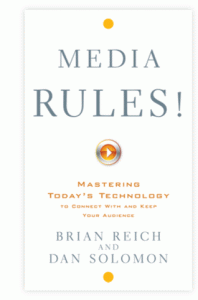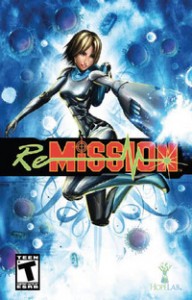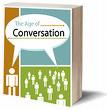 We interrupt this series on product placement and new FCC media rules to add a very pertinent voice into the mix, digital dynamo Brian Reich, co-author with Dan Solomon of Media Rules!
We interrupt this series on product placement and new FCC media rules to add a very pertinent voice into the mix, digital dynamo Brian Reich, co-author with Dan Solomon of Media Rules!
Brian Reich understands new media’s opportunity to do positive, GOOD things beyond just ‘sell stuff’ so before I dive further into my Part 3 stance on the need for disclosure and transparency, I thought it would be wise to hear from this noble gent, who also happens to be a young parent, net neutrality advocate, and social change agent in the ‘how to make a real difference’ realm.
Full disclosure will reveal that Brian is also one of my fellow probono co-authors at The Age of Conversation ’08, to benefit Variety, The Children’s Charity, and formerly the New Media Director at Cone cause-branding, known for its insightful innovation in corporate social responsibility.
Brian Reich parlayed his mastery of emerging technology to be a Principal at the wicked-smart online firm EchoDitto. This dynamic digital agency is all about empowering communities into multi-person conversations rather than one-way marketing projects that tend toward wham-bamm grab-n-go wallet pilfering. They elevate dialogue into a give and take respectful presence rather than a pushy proposition…
I was fortunate to meet Brian’s cohort, EchoDitto partner Nicco Mele (who was deemed ‘one of America’s best and brightest’ by Esquire magazine and wow do I agree!) when Brian invited me as a guest panelist to Cone’s American Heart Association strategy session on how to engage youth in the cause.
Nicco led the guest panel and blew me away with his rapid-fire command of new media’s potential to do good things, so as sad as I was when I heard Brian left Cone, a big grin came over my face when I heard he’d landed at Nicco’s EchoDitto environs! (their clients include orgs like Ashoka: Innovators For The Public, Seventh Generation, U.N. World Food Programme, World Trade Center Memorial Foundation, Rock The Vote, Independent World Television, Pearl Harbor Memorial Fund) Ironically, even though I’m quite familiar with his work, I still haven’t met Brian face to face, as his wife was in the final days of expecting, so the papa-to-be couldn’t make it to his own conference…but his knowledge of new media’s roles and rules far supersedes my own…
So as we discuss FCC new media conversations and the need for transparency, disclosure, and non-invasive authenticity that doesn’t disrupt the entertainment value itself, I think it’s important to hear from him.
The powerful potential of using new media with accountability and responsibility is vital, whether you’re a nonprofit, a for-profit, or an NPTech guru/Twitter fundraising fiend like Beth Kanter, for that matter. The rules are jelly, the frontier vast, with ubiquitous spam, pop-ups, and product placements capable of annoying or enjoying…You can transform, inspire, offend, or mea culpa in a keystroke, coming under fire faster than you can sneeze.
It’s vital to see ALL sides of an issue in order to fully understand the nuances before you can even develop the ‘rules’ much less the deployment and governance of same.
How does the media message impact public health? Children? Developing nations? Food chains? Agriculture? The environment and economy?
What are the new media implications with mobile technology? Gaming? Virtual worlds? Social change agents and advocacy? Commercialism and consumption? Is there a way to create a media version of the Hippocratic oath to do no harm?
What will the public tolerate or embrace, with new media empowerment? Seems like much has to do with nuanced, respectful, unobstructed candor, relationship building and trust…It doesn’t take place overnight in a money-grab for insta-cred. After all, I’ve been seeding Shaping Youth’s content for well over a year now, to hear from all elements in our consortium…youth, parents, private and public interests, institutions, industry colleagues, you name it.
It’s important to listen to needs before you can begin to address them. Sure, I was offered ‘ad rev’ from the get go, and instead chose to let this tiny org grow holistically to see what would bloom out of like-minded entities…I may be a bit on the impoverished side, but I have no regrets for taking my time in pre-launch to explore best practices and experiment with what could sustainably ‘stick.’
So what ARE the media rules? How can we play fairly and create good ones?
How can we harness the power and potential of youth and digital technology for positive change where it’s a ‘win-win’ for all?
Let’s face it, despite media’s potential role in the greater good of public health for the planet and humankind, regulatory mandates are usually introduced due to breach of trust and no-holds-barred greed that rears its ugly head in a failure to self-rein…Sure ‘we can solve it’…but:
 Whether it’s EPA eco-standards, or the need for investigating energy drinks, functional and dietary supplements by the FDA, or the FCC investigation of product placement proliferation in every synapse vying for media mindshare, at the very core there’s usually been a violation of trust and power.
Whether it’s EPA eco-standards, or the need for investigating energy drinks, functional and dietary supplements by the FDA, or the FCC investigation of product placement proliferation in every synapse vying for media mindshare, at the very core there’s usually been a violation of trust and power.
How can we use media rather than having media use us? Let’s ask Brian Reich, co-author of Media Rules!
Shaping Youth: How do you see ‘Virtual Events’ like EarthHour.org or Virtual Walk For Water impacting youth participation in a cause?
Do they ‘work’ beyond point & click enrollment to sustain interest in a cause? Or is it more awareness and short bursts of activation or buzz-building?
 Brian Reich: I think we still have a long way to go before organizations figure out how to convert the interest demonstrated for virtual events into real, meaningful, measurable action to address a social issue.
Brian Reich: I think we still have a long way to go before organizations figure out how to convert the interest demonstrated for virtual events into real, meaningful, measurable action to address a social issue.
Right now, they seem comfortable measuring their success by the size of their email list or the amount of money they raise. Those are good metrics, but they don’t correlate directly to a major shift in the way we operate our lives.
To accomplish that, we are really talking about changing people’s behaviors (i.e. consuming less energy in every aspect of our lives, not just turning out the lights for one hour) and that takes time. We are moving in the right direction as a society, and learning what works and doesn’t work, and that’s what is important right now.
That is particularly true with young people, where the competition for their time and attention is so great that getting a major commitment of time from them can be a real challenge (ok, that might be true for everyone, not just young people).
 If you can get a young person to sign up, get more information, play a game, or whatever — that’s IS an accomplishment. But having them show up every Saturday morning for two hours to help clean up a blighted neighborhood, or following through on their commitment to consume less energy (when their parents are still buying gas guzzling vehicles) is a whole different thing.
If you can get a young person to sign up, get more information, play a game, or whatever — that’s IS an accomplishment. But having them show up every Saturday morning for two hours to help clean up a blighted neighborhood, or following through on their commitment to consume less energy (when their parents are still buying gas guzzling vehicles) is a whole different thing.
There have been some limited successes, but for the most part, we see lots of excitement and buzz, but very little actual change. We’ll get there!
Shaping Youth: How do you think we can best leverage mobile and youth technology for social change, enrolling youth in the user-generated content process like Jon did with Step it Up 2007 for climate change?
Brian Reich: The more relevant and timely information you can create and distribute, or the more compelling events you can organize and involve people in, the greater likelihood you will have of success when it comes to communications and organizing.
 Mobile/youth technology is perhaps the most powerful toolset we now have to capture and promote good information and/or to involve more people in events and experiences.
Mobile/youth technology is perhaps the most powerful toolset we now have to capture and promote good information and/or to involve more people in events and experiences.
Think about it: if everybody carried a tiny video camera around, then we would have an even greater ability to raise awareness about important happenings — as they happen — instead of waiting for the media to frame it.
With everyone, of all ages really, carrying cell phones, we should be looking for more ways to drive action via cell phone — so we don’t have to wait for someone to back to their computer and log on to make a difference. A single image, a quick Twitter post, anything can have a dramatic impact on how we understand the world and interact with each other. We should use technology to put ourselves, our communities, and our society in a position to understand and act more — and I think mobile/youth technology certainly does that.
Shaping Youth: What are your top three case studies of using the power of media for positive change?
Brian Reich: I always look to the “serious games.” (Amy’s note: this is a ‘category’ of games that educate via digital learning, much like Ayiti, the Cost of Life, or Playnormous, or HopeLab’s games which we’ve written about here before)
The people who are introduced these games come away with a deeper understanding of the complex issues behind them, not just an entertaining experience or a feel-good click through…That is so powerful…games like MTVu’s Darfur is Dying which can reasonably be credited with raising awareness of the genocide in Darfur and driving greater U.S. interest and intervention or ReMission which gives kids battling cancer a way to understand and ‘fight’ their disease.
Shaping Youth: Do you feel our use of the term ‘counter-marketing’ is negative or needs repositioned to align with your Media Rules?
Brian Reich: I think we need to re-align the concept of marketing as a whole. Marketing is focused on managing one yo-yo campaign after another…make a big splash, then go dark, make a big splash, then go dark and so on.
As technology’s role in our lives continues to expand, we are seeing a shift in how society operates — how we get and share information, what drives our decision-making, and of course how we interact with organizations and each other.
We want to have a relationship with an organization, trust the information that we are given (and the people who give it to us), feel confident that the products we buy or causes we involve ourselves in are worth our limited time and resources. Marketing undermines that, because it is all about a single transaction with little recognition of the value of an ongoing relationship.
Changing marketing means shifting to focus more on conversation, building trusted relationships, being accessible in the ways and at the times your audience expects, guiding and supporting them in their decisions, their usage of products, whatever. I firmly believe that if you operate in that way — if you deliver good information, create compelling experiences, or offer and support high quality stuff (the basic premise of my book, Media Rules!) then everything else will fall into place. But, if you focus on a single sale, a little campaign, whatever, you will fall short.
So, we shouldn’t limit ourselves to a conversation about marketing or counter-marketing — we should be elevating the whole standard of communications to a point that organizations (companies, nonprofits, educators, entertainers, everyone) understand that we are all connected and do better in terms of recognizing what their audience wants delivering against those expectations. (Amy’s note: pdf/sample chapter, “Be Fresh” from Media Rules!
Shaping Youth: Shifting from Cone to EchoDitto, what new challenges/opportunities are you seeing in the youth advocacy sphere in terms of emerging media and technology?
Brian Reich: Harnessed correctly, the internet can enliven debate and inspire ordinary Americans to reengage in their communities. The internet empowers people to get educated and get engaged, not just online but offline as well.
 This is particularly true around advocacy and youth advocacy (because of the high level of adoption among young people when it comes to technology and because of their interest in contributing to the operation of our society) — probably now more than any generation at their age ever!
This is particularly true around advocacy and youth advocacy (because of the high level of adoption among young people when it comes to technology and because of their interest in contributing to the operation of our society) — probably now more than any generation at their age ever!
The basic premise is that the internet will further decentralize information and only organizations that embrace this will thrive. Organizations have to fundamentally shift the way they operate, the way they communicate, and how they engage their audience. They have to give up control and welcome, no embrace, the role that their audience can play in extending the reach and impact of their work.
The challenge? For nearly every organization this means a wholly different way of existing. Until an organization has seen this new order perform in their specific area of interest, in a context that they understand, they aren’t willing to make the leap…
If you wait until the change has been proven and demonstrated, however, it will have long ago passed you by…
Shaping Youth: Thanks, Brian looking forward to more conversations…(On Media Rules! as well as media rules)…It’s shaping up to be an evolutionary, revolutionary time.
Visual credits: EcoSherpa recycle logo, istockphoto,











Brian rocks!
Yep, he sure does, Beth! (as do YOU!) Wish I could hear your talk at BlogHer…hopefully you can post and live-blog the conference for those of us who fouled up and waited too long…I’ll be checking out the Second Life keynotes and such, but sure wish I could see everyone in person…sigh. Best, Amy